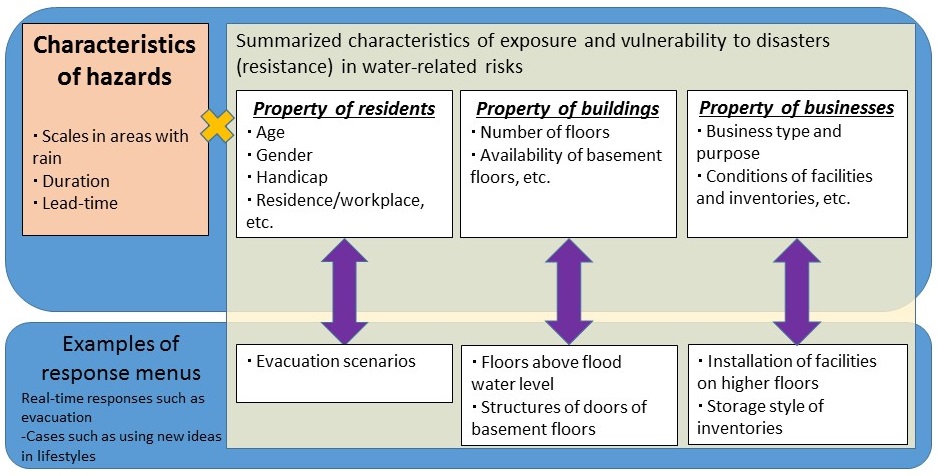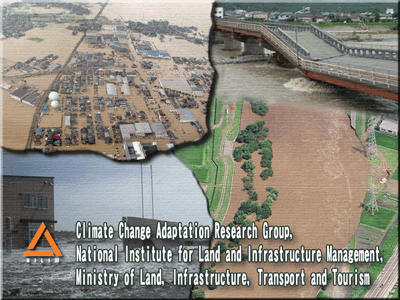"Climate Change Adaptation Strategies to Cope with Water-related Disasters due to Global Warming "
, a policy report by the Panel on Infrastructure Development, MLIT, submitted in June 2008, makes the following assertions :
- Climate change due to global warming caused by human activities is expected to have such great and serious impact that it is an important issue that affects the foundations of human survival.
- Climate change has impact in wide varieties of fields such as ecosystem, fresh water resources, food, coastal and low-lying areas, industries and health.
- In coastal and low-lying areas in particular, rising sea levels, more frequent occurrence of heavy rain, more severe typhoons, etc. cause more frequent and catastrophic flood, sediment, high tide and other disasters. More frequent and serious droughts due to the increase of rainfall fluctuation range are of concern.
- The fourth assessment report of the Intergovernmental Panel on Climate Change (IPCC) notes that measures for alleviating global warming focused on reducing CO2 and other greenhouse gases have limited effects and that temperature will continue rising for centuries even if alleviating measures are taken, so IPCC suggests adaptation as well as alleviating measures should be taken to control various effects of global warming.
- National governments are basically responsible for ensuring the security and safety of people, so they should quickly review and implement climate change adaptation measures from a long-term viewpoint including the development of preventive facilities.
The report points out that the effects of climate change on flood disasters are now being identified scientifically in Japan but that no adequate discussions have yet been made on the specific measures adapted to climate change although the country is more vulnerable to disasters than any other advanced countries. Some advanced countries have been not only making efforts to reduce greenhouse gases to alleviate global warming but also taking such climate change adaptation measures as ensuring required levee height to resist the rise of sea level.
In view of the above situation and recognition, the National Institute for Land and Infrastructure Management (NILIM) considered it an immediate task to identify the effects of global warming on people in relation to flood disasters, present various technical policies adapted to climate change and develop and spread technologies to implement the policies, and established
the Climate Change Adaptation Research Group on April 1, 2009.
Establishing the Group helped further integrate impact assessment and adaptation measures research activities that separate departments had been conducting. As a result, an organizational setup was developed for promoting cross-cutting research to meet overall goals making use of the characteristics of respective research departments and center (Water Quality Control Department, River Department, Road Traffic Department, Urban Planning Department, Coastal, Marine and Disaster Prevention Department and Research Center for Infrastructure Management) that participate in the research.
We will refine our expertise we have developed over a long period of time through the implementation of technical policies for preventing or reducing flood disasters, to adapt ourselves to climate change, an emerging issue; visualize the problems we are faced with from a long-term viewpoint; and offer fundamental knowledge for supporting the proposal and implementation of technical policies in order to build society that can intelligently adapt to climate change.
|
Study of methods to reduce risks of flood damage integrated with urban planning
|
1. Necessity of the joint effort to reduce disasters with societies
As we face the risk of increased intensity and frequency of water-related disasters caused by climate change, societies are expected to steadily develop infrastructures and implement disaster reduction measures integrated with urban planning (example: responses in the Social Infrastructure Development Council, “Ways to adapt to climate change in the field of water-related disasters – To share the information of disaster risks and sense of crisis to build a society to reduce disasters – “ August 2015). The team started a study of measures to reduce disasters in urban planning and lifestyles and methods to evaluate them by focusing on cities with high vulnerabilities and identifying the vulnerabilities to water-related disasters. This paper introduces this study.
2. Three focuses
(1) Identification of flood hazards for both overland flooding and river flooding
Many hazard maps have been created for class 1 water systems if the annual flooding probability is 1/100 to 1/200 and the external force of flooding with the scale of 1/5 to 1/10 of sewage planning (overland flooding and river flooding). Yet, hazards are not well known for overland flooding that exceeds 1/100, such as cases of so-called guerrilla rainfall and cases with simultaneous overland flooding and river flooding. Thus, the team develops methods to analyze actual flooding hazards for various external forces, such as for a case in which the overland flooding expands to a scale that exceeds 1/100 and a case in which overland flooding is joined to river flooding.
(2) Interpretation of damage risks from flooding hazards based on urban diversity
Even when the information of hazards, such as flooding depths, is released, business owners and residents cannot easily understand what kind of risks they are facing. Thus, the team analyzed characteristics (attributes) of buildings, business owners, and residents for which flood damage can be defined. The team then developed a model to convert the obtained information into information on the damage risks for specific urban conditions (Fig.-1). For example, the evaluation of the relationship between flooding depths and damage to assets for individual attributes of buildings will enable the identification of damage risks as well as the quantitative evaluation of the effects of damage reduction measures, such as the use of piloti, water stops, and the relocation of assets.
(3) Suggestions for measures based on regional abilities to prevent and reduce damages
Even if detailed information on the hazards and risks is released, it is meaningless unless local governments, business owners, and residents can understand what kind of measures they should combine. Thus, the team also looks for methods to present the information by examining proper response menus for specific damage prevention measures and abilities (strengths and weaknesses of society) of above attributes and target areas to reduce damage.
3. Research system integrated with urban planning and damage prevention departments
Three-year cross-sectional research studies are being implemented using the system from the Climate Change Adaptation Research Group in which the following research divisions related to river and wastewater management, urban planning, and disaster prevention can work together: River Department (River Division, Water Cycle Division, Flood Disaster Prevention Division); Urban Planning Department (Urban Planning Division, Urban Disaster Mitigation Division);Water Quality Control Department (Wastewater System Division); and Research Center for Land and Construction Management (Research Coordinator for Land Management and Disaster Prevention). Practical case studies will be implemented in the future with local governments in model areas.
|

|
Fig-1. Interpretation of risks from hazards based on various
property in cities and concept of presenting menus of responses to the risks
|
 |
Contact us
Climate Change Adaptation Research Group
National Institute for Land and Infrastructure Management,
MLIT, JAPAN
1 Asahi, Tsukuba City, Ibaraki Prefecture 305-0804
E-mail: nil-kikou#ki.mlit.go.jp
(Please replace "#" by "@" when you send e-mail.)
|
|